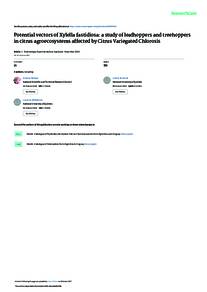وثيقة
Potential vectors of Xylella fastidiosa : a study of leafhoppers and treehoppers in citrus agroecosystems affected by citrus variegated chlorosis.
المعرف
DOI: 10.1111/eea.12491
المساهمون
الناشر
Blackwell.
ميلادي
2016-11
اللغة
الأنجليزية
الملخص الإنجليزي
This study investigated the predominant leafhopper and treehopper (Hemiptera, Auchenorrhyncha) species in Citrus Variegated Chlorosis (CVC)-affected citrus agroecosystems in Argentina, their seasonal fluctuation, and their potential role as vectors of Xylella fastidiosa Wells et al., using molecular methods for detection. More than 6 000 Auchenorrhyncha were collected from three citrus agroecosystems over a period of 3 years using yellow sticky traps and entomological nets. Cicadellidae and Membracidae were the most abundant families. Of the 43 species identified, five were predominant in citrus orchards, and three were predominant in weeds surrounding citrus plants. All predominant species and another four non-predominant species tested positive for X. fastidiosa in PCR and real-time PCR assays. In a transmission assay, Dechacona missionum (Berg), Tapajosa rubromarginata (Signoret), and Cyphonia clavigera (Fabricius) transmitted X. fastidiosa successfully. Scaphytopius bolivianus Oman and Frequenamia spiniventris (Linnavuori) populations increased once (during the summer), possibly due to favorable weather conditions, and Bucephalogonia xanthophis (Berg), Molomea lineiceps Young, and T. rubromarginata populations increased twice a year: once in summer and once in winter, coinciding with the increase in early citrus shoots (flush). Among the X. fastidiosa-positive species, those with the higher population densities during the sprouting period, where trees are highly susceptible to infection, must be considered as most relevant vectors of CVC in the citrus-growing areas in Argentina.
المجموعة
ISSN
0013-8703
URL المصدر
قالب العنصر
مقالات الدوريات

